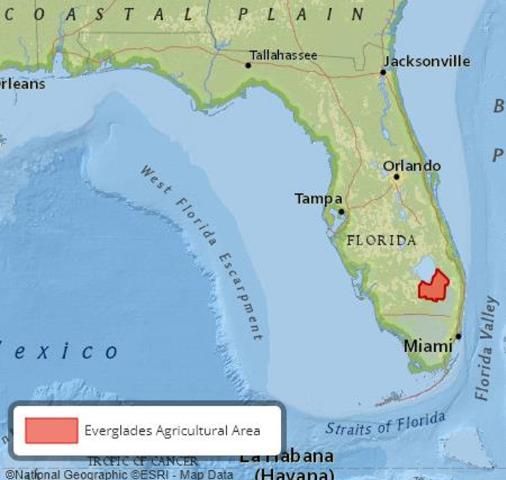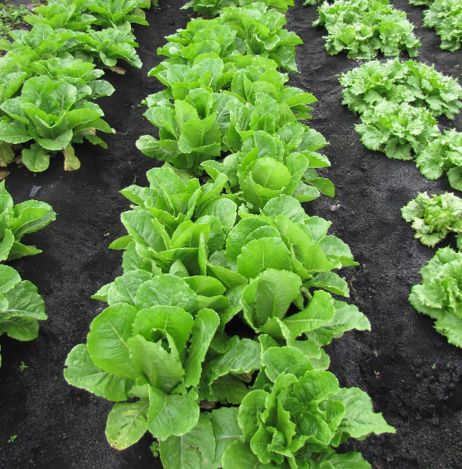Introduction
Lettuce (Lactuca sativa L.) is an economically important winter vegetable crop in Florida, with approximately 11,000 acres in production and a farm gate value of $70–$80 million annually. Florida lettuce production occurs mainly in the Everglades Agricultural Area (EAA) (Figure 1), located just south of Lake Okeechobee in Palm Beach County, in a rich organic soil called "muck" (Figure 2). Iceberg and romaine are the predominant types of lettuce grown in Florida. Lettuce production typically begins in late September and finishes in early May.

Credit: Gustavo F. Kreutz, UF/IFAS

Credit: Germán V. Sandoya, UF/IFAS
Historically, the University of Florida lettuce breeding program released valuable cultivars to the lettuce breeding industry, including 'Tall Guzmaine', 'Short Guzmaine', and 'Floriglade', which were the last cultivars released by the UF/IFAS lettuce breeding program (Guzman 1986). The importance of 'Tall Guzmaine' is outstanding; it has been incorporated as parental breeding material in modern romaine cultivars planted in the United States and abroad.
Table 1 presents a summary of lettuce cultivars released by the University of Florida lettuce breeding program by Dr. Victor Guzman (in memoriam), with information on diseases and a physiological disorder commonly affecting lettuce growers in south Florida.
Cultivars currently used in Florida lettuce production were exclusively developed by the private sector. These cultivars are planted in three distinct production seasons in south Florida—early planting in the fall, intermediate planting in the winter, and late planting in the spring. Some of the iceberg, romaine, leaf, and Bibb lettuce cultivars used are listed in Table 2.
Although each private lettuce-breeding program has its own variety trials, decisions and recommendations for released cultivars are based on visual observations in the field. Data on effects of current cultivars, production locations, and their interactions on lettuce yields are limited.
In 2010 and 2011, variety trials at the UF/IFAS EAA included commercial cultivars and UF/IFAS breeding lines, including romaine and iceberg types (Lu et al. 2011; Lu and Sui 2012). These trials were conducted on muck soils following UF/IFAS-recommended practices. In 2010, experiments were planted in early fall planting season on October 22 and in mid-winter planting season on January 23. In 2011, experiments were carried out in early season in fall with a planting date of October 13 and in mid-season (transition between fall and winter planting seasons) with a planting date of November 26. Overall, yield was lower in 2010 than in 2011 because three freezes in December 2010 caused plant damage to early-season trials.
Several romaine, iceberg, and Bibb lettuce lines were assessed for yield and marketability in 2017.
Cultivar and UF Breeding Lines Characteristics
Cultivars
'Manatee': 'Manatee' is historically important in Florida's lettuce production and was the major cultivar before 2011. However, it did not have good yield overall in variety trials, particularly in 2011 (Table 1), because it had low yield in the mid-season trials. 'Manatee' has resistance to early bolting and grows better in the early growing season (from late September to early October) and late growing season (from middle of April to early May) when temperatures are high. This cultivar can be used in lettuce production in both the early and late growing seasons when other cultivars are not suitable for production due to hot weather. 'Manatee' also has medium resistance to aphids.
'Terrapin': This romaine cultivar had the highest yield and the highest percent of marketable heads in variety trials (Table 1). It can be planted from November to January and harvested in January through March to maximize profits.
'Okeechobee': This cultivar yielded well in the variety trials, and its yield was stable across years (Table 1). 'Okeechobee' is suitable for production in the months from November through April.
'Gator': 'Gator' is an iceberg cultivar used for lettuce production for many years. In the variety trials, it had the highest yield among the iceberg cultivars in 2010 but the lowest yield in 2011 (Table 2). However, the yields of all three iceberg cultivars were not significantly different in 2011. 'Gator' can continue to be used as a major cultivar in lettuce production in south Florida.
'Raleigh': 'Raleigh' is an old variety released in 1984 (Guzman 1984). This variety had low yield in 2010 but high yield in 2011. Because 'Raleigh' is an east-coast type of lettuce and farmers in the EAA area no longer grow this kind of lettuce, this variety is not recommended for production.
UF Breeding lines
'70096': This romaine breeding line yielded poorly in 2010 because it had early bolting in the late-season trials that year, but it had good yield in 2011 (Table 1). This variety showed strong resistance to banded cucumber beetle and was found to be cold-tolerant and seed-thermo-dormancy-resistant in the variety trials (Lu et al. 2011; Lu and Sui 2012). However, '70096' is tipburn sensitive and is aphid-susceptible.
'8074': This breeding line had stable yield across years (Table 2). Although its head looks relatively small, leaves of the head are tightly compacted, making the head relatively heavy.
Management
All cultivars except for '70096' and 'Raleigh' are recommended for lettuce production in Florida. The following management practices for lettuce production in Florida have been designed by UF/IFAS Extension specialists based on research results and are available online.
Fertilization: See Hochmuth et al. (2009; 2012) for recommendation of fertilization (https://edis.ifas.ufl.edu/wq114 and https://edis.ifas.ufl.edu/cv008).
Insect management: Information is available in UF/IFAS fact sheets CIR1460 (Mossler and Dunn 2005, https://journals.flvc.org/edis/article/view/114335/109652) and Vegetable Handbook https://edis.ifas.ufl.edu/publication/CV293.
Disease management: The major diseases of lettuce in Florida and their management are described in Raid (2004).
Weed control: Control of weeds in lettuce is described in Dittmar and Stall (2013, https://edis.ifas.ufl.edu/wg031).
References
Dittmar, P., and W. Stall. 2013. Weed Management in Leafy Greens (Lettuce, Endive, Escarole, and Spinach). HS203. Gainesville: University of Florida Institute of Food and Agricultural Sciences. https://edis.ifas.ufl.edu/wg031
Guzman, V. L. 1984. 'South Bay' and 'Raleigh', Two Crisphead Lettuce Cultivars Resistant to Corky Root Rot for Organic Soils. Circ. S-310. Gainesville: University of Florida Institute of Food and Agricultural Sciences.
Guzman, V. L. 1986. 'Short Guzmaine', 'Tall Guzmaine', and 'Floriglade', Three Cos Lettuce Cultivars Resistant to Lettuce Mosaic Virus. Circ. S-326. Gainesville: University of Florida Institute of Food and Agricultural Sciences.
Hochmuth, G., Ed. Hanlon, R. Nagata, G. Snyder, and T. Schueneman. 2009. Fertilization Recommendations for Crisphead Lettuce Grown on Organic Soils in Florida. SP153. Gainesville: University of Florida Institute of Food and Agricultural Sciences. https://edis.ifas.ufl.edu/wq114
Hochmuth, G., E. Hanlon, G. Snyder, R. Nagata, and T. Schueneman. 2012. Fertilization of Sweet Corn, Celery, Romaine, Escarole, Endive, and Radish on Organic Soils in Florida. BUL313. Gainesville: University of Florida Institute of Food and Agricultural Sciences. https://edis.ifas.ufl.edu/cv008
Lu, H., A. Wright, and D. Sui. 2011. "Responses of Lettuce Cultivars to Insect Pests in Southern Florida." HortTechnology 21(6): 773–778.
Lu, H., and D. Sui. 2012. "Field Performance of Lettuce Cultivars Used in Southern Florida." 2012 FSHS Proceedings 125: 137–138.
Mossler, M. A., and E. Dunn. 2005. Florida Crop/Pest Management Profile: Lettuce. CIR1460. Gainesville: University of Florida Institute of Food and Agricultural Sciences. https://journals.flvc.org/edis/article/view/114335/109652
Nuessly, G. S., and S. E. Webb. 2010. Insect Management for Leafy Vegetables. ENY-475. Gainesville: University of Florida Institute of Food and Agricultural Sciences. https://edis.ifas.ufl.edu/ig161
Raid, R. N. 2004. "Lettuce Diseases and their Management." Diseases of Fruits and Vegetables. 121–147.
SAS Institute. 2010. Cary, NC. http://www.sas.com
University of Florida historical lettuce cultivar releases of iceberg, romaine, and Bibb types.
Partial list of lettuce cultivars of iceberg, romaine, leaf, and Bibb types currently planted in the EAA in south Florida.
Yield (lb/ac) and marketable heads (MH) (%) of romaine lettuce grown in Belle Glade, FL, in 2010 and 2011 seasons.
Yield (lb/ac) and marketable heads (MH) (%) of iceberg lettuce grown in Belle Glade, FL, in 2010 and 2011 seasons.